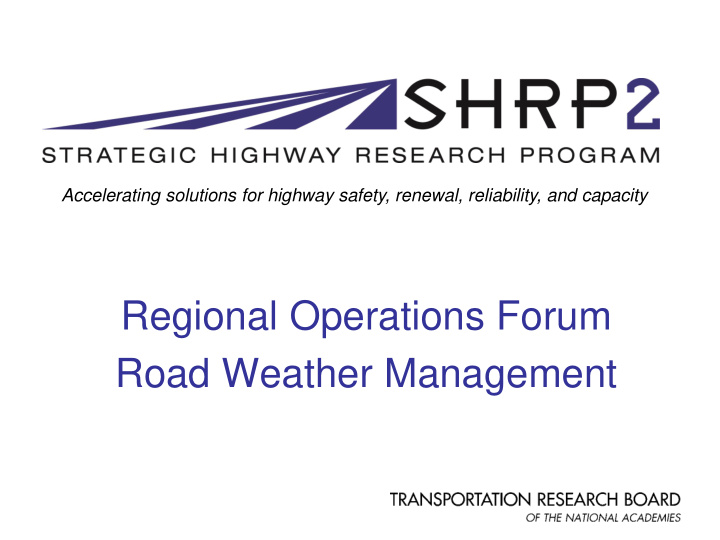



Accelerating solutions for highway safety, renewal, reliability, and capacity Regional Operations Forum Road Weather Management
Session Objectives • Provide high-level awareness of road weather management • Develop awareness of principles and elements associated with modern road weather management • Understand how to implement elements of road weather management 2
The Road Weather Problem • Safety: – 1.57± million weather-related crashes/year • 7,400 fatalities; 690,000 injuries – 24% of all crashes occurred on slick pavement or under adverse weather • Mobility: 15% of delay caused by bad weather • Productivity: Weather-related delay adds $3.4 billion to freight costs annually • Environment: Chemicals effect watersheds, air quality and infrastructure 3
Types of Weather • Winter weather – Snow, especially first snow – Blowing and drifting snow – Freezing rain • Rain – Especially heavy rain or first rain • Limited visibility – Fog or dust/sand storms • Frost 4
Weather Effects on Traffic Operations • Reduced Visibility • Reduced Roadway Friction • Reduced Roadway Capacity • Damaged Infrastructure • Blocked Roadways • Inundated Roadways and Flooding • Coastal Evacuation • Increased Speed Differential • Increased Driver Stress 5
Weather Data and Information Sources • Road Weather Information Systems (RWIS) — Fixed sensors and mobile sensors • Weather observing systems – Automated Surface Observing Systems (ASOS) — NOAA – Automated Weather Observing Systems (AWOS) — FAA – Both provide the basis for NWS forecasts • MADIS 6
Road Weather Information System (RWIS) • Environmental sensor stations (ESS) to collect data • A communication system for data transfer • Central server to process data • Dissemination of information to agencies/motorists 7
How is RWIS used? RWIS� INFORMATION� STAKEHOLDERS� NEEDS� MAINT� ESS� NWS� CAMERAS� WSP� TRAFFIC� TMC� NWS� 511� 8
Michigan RWIS Deployment 10
Available Weather Resources 11
Meteorological Assimilation Data Ingest System (MADIS) • Collect, integrate, quality control, and distribute observations from NOAA and non-NOAA organizations. • Leverages partnerships with multiple partner agencies to integrate observations – Including state departments of transportation – Provides a finer density, higher frequency observational database for use by the greater meteorological community • MADIS runs operationally in real time in the National Weather Service (NWS) • Many states are making RWIS data available to MADIS 12
Weather Forecasts • All weather observations can improve weather forecasts – The more information, the better – National Weather Service – Private meteorological services • RWIS performs double duty – RWIS information is used directly by maintenance crews, supervisors, and managers – Information from RWIS feeds and improves weather forecasts 13
Benefits of Reliable Weather Forecasts • Improved resource allocation – Crews sent to the right places at the right times – With the right equipment – With the right treatment material (and the right amount) • Effective resource allocation results in safer roads and reduced costs A key to effective road weather management is timely and accurate forecasts and measurements. 14
Pavement Condition Prediction • Forecasts of pavement temperatures and conditions • Supporting information for treatment decisions – When and if to treat – What type of treatment to use • Valuable input to maintenance staff for resource allocation 15
Weather Responsive Traffic Management (WRTM) • Three types of WRTM strategies – Advisory strategies provide information on prevailing and predicted conditions • Posting fog warnings on dynamic message signs • Listing flooded routes on web sites – Control strategies alter the state of roadway devices to permit or restrict traffic • Reducing speed limits with variable speed limit signs • Modifying traffic signal timing based on pavement conditions – Treatment strategies supply resources • Most common treatment strategies are application of sand, salt, and anti-icing chemicals to pavements 16
Maintenance Decision Support System (MDSS) • System to support winter maintenance activities • Capitalizes on existing road and weather data sources – Augments data sources where they are weak or where improved accuracy could significantly improve the decision-making task – Fuses data to make an open, integrated, and understandable presentation of current environmental and road conditions • Proactive resource management, equipment management, cost management for highly variable winter operations 17
18
,000 19
MDSS Benefits • Indiana DOT program benefits – Statewide implementation 2009 – Saved 228,000 tons of salt = $12M – Saved 58,000 hours of overtime = $1.4M • One-stop for winter weather information • Consistency in tracking/reporting among regional maintenance groups • Supports proactive training • Looking toward mobile data collection capabilities 20
Road Weather Management Performance Measures • Will differ on types of weather encountered • Will differ by agency objectives • Sample measures – Regain time • Time to return to “normal” seasonal conditions – Coefficient of friction or “grip” factor – Benefit – Cost • What weather related performance measures does your agency use? 21
Notable Trends • Open RWIS architecture • Noninvasive sensors • Importance of camera imagery • Mobile data collection and AVL • Multistate weather response coordination • Interest in connected vehicles • Integration of weather and traffic management (@ TMC) – Including traveler information • Emphasis on performance measurement 22
Group Discussion • What weather events do you have to manage? • What road weather management tools do you use? • What has been successful? • What are the gaps you still have? • What new equipment, systems, or processes are you developing or exploring? 23
Weather Takeaways • Do you take advantage of all the weather resources available to you (appropriate to your role)? • Has your agency looked into mobile weather data collection? • Has your agency looked into the MDSS? Does it use it? 24
Recommend
More recommend